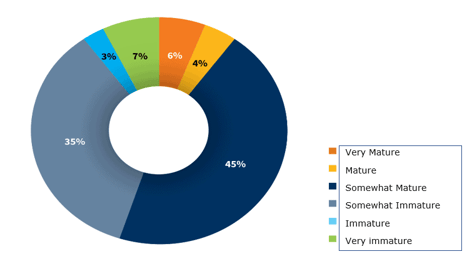5 Steps to Resource Management Maturity
Where do you stand with your resource management maturity?
About 55% of respondents in our 2019 GAUGE Report said they have reached resource management maturity for their organization. Does your business fit into this category?

Resource Management Maturity
People really are the most important asset a company has, yet so many companies struggle to truly manage this resource. How much more profitable would you be if you increased utilization of your resources? How much more on-time would your projects be if you had the right people at the right time for the right tasks?
In this blog, we’ll walk you through 5 steps to resource management maturity so you can see not only at what level your organization currently sits, but where you'd like to go in the future.
Resource Management Maturity Level One – Ad-Hoc or Initial
At this level, achieving resourcing goals depends on individual effort and heroics. Work gets done but it is not sustainable for the long term, and key staff may be lost to burnout.
How to move from Level One to Level Two:
- Agree as an organization that you are ready to mature your resource management practice!
- Create and document policies and procedures
- Policies should establish best practices for your organization
- Assure they will help the teams be successful
- Make sure there is a repository for easy access
- Feedback loop to make sure policies are being followed
- Create a self-audit plan
- Concentrate on the basics – resource names, availability, skills, and utilization
- Define Key Performance Indices (KPIs) for your project
- Provide role-based training on policies and procedures
- Evaluate tools and evaluate future needs
Resource Management Maturity Level Two – Project by Project or Basic
In level two, resource management processes are in place and the necessary process discipline exists to repeat earlier successes on projects with similar applications.
How to move from Level Two to Level Three:
- Measure adherence of enterprise policies and procedures
- Information is shared across projects with modern tools
- Enterprise wide labor categories and skills inventory/classifications
- Defined skill levels used for resource selection
- People, processes & tools provide an enterprise wide resource forecast
- Resources are budgeted and forecasted at the task level
- Supply and future supply of resources is visible
- Resource demand is visible to all project stakeholders
- Projects are being planned with resource constraints in mind
- Decide on a common set of enterprise wide and project level KPIs
- Automation of the process with the right tool
Resource Management Maturity Level Three – Organization-Wide
Processes are documented and standardized at level three, with approved tailored approaches being adopted as needed.
How to move from Level Three to Level Four:
- Use data (historical and current) to drive hiring and placement decisions
- Common tool for enterprise level resource and skills budgeting and forecasting that all stakeholders have access to
- Formal resource requesting process
- Standard resource management metrics/KPIs with visibility of performance goals/thresholds
- Self-reporting on utilization
- Align resource forecasts and plans to corporate goals and objectives
- Realtime resourcing information – reports and dashboards
- Utilize KPIs to directly influence achievement of business goals and to make great business decisions
- Pipeline is also resourced for full look at the total needs of the business
- Tools now support the process with minimal manual touches
- Continue role-based training for all stakeholders
- Tools training is a recurring activity
Resource Management Maturity Level Four – Quantitative/Data Driven
At level four, detailed measures on process of resourcing practices are quantitatively measured, understood and managed.
How to move from Level Four to Level Five:
- Invest in your people with training and a career path
- Establish a continuous feedback loop from all stakeholders
- Incentivize employees to be creative and listen to the suggestions
- Continue to evolve your processes looking for areas to improve
- Collect and utilize lessons learned and drive them into your process
- You will feel the organization firing on all cylinders
Resource Management Maturity Level Five – Continuous Improvement
At the final level of the resource management maturity level, continuous process improvement is enabled by quantitative feedback from the process and from piloting innovative ideas and technologies.
“Sounds great, but do we have to be a Level Five?”
As an organization, it is important to decide what level is needed to achieve your business objectives. You might not need to walk through all 5 steps to resource management maturity. Some may say that level 3.5 is adequate and it will meet their needs. Others might need a complete managed process that is striving for optimization, so a 4.3. Making that decision is key to establishing a roadmap and overall timeline.
Benefits of Adopting a Resource Management Maturity Model:
- Improved visibility and control into enterprise resource needs and utilization
- Improved predictability and understanding of overall performance
- Common organizational standards ensuring consistent reporting, reduction of rework, and reduced dependence on heroes.
- Optimization of the project management staff, allowing them to focus on their customer, not on turning the crank.
- More efficient communication within project teams and to senior leadership.
- Delivery of real-time insight on project financials and enable resolution of identified risks.
- More on-time and on-budget projects, which equals a delighted customer.
Mature Your Resource Management Process with Unanet
Understanding that resource management is a true discipline that should be practiced and matured can be the difference between successful or failed projects. We all know what happens with failed projects and none of us want that.
A resource management system can greatly aid your mission to improve your resource management maturity. An integrated comparison of actuals with budgets, plans, plans and variances gives project managers unparalleled insight into their projects.
Dive deeper into how to improve your resource management maturity by watching our on-demand webinar.